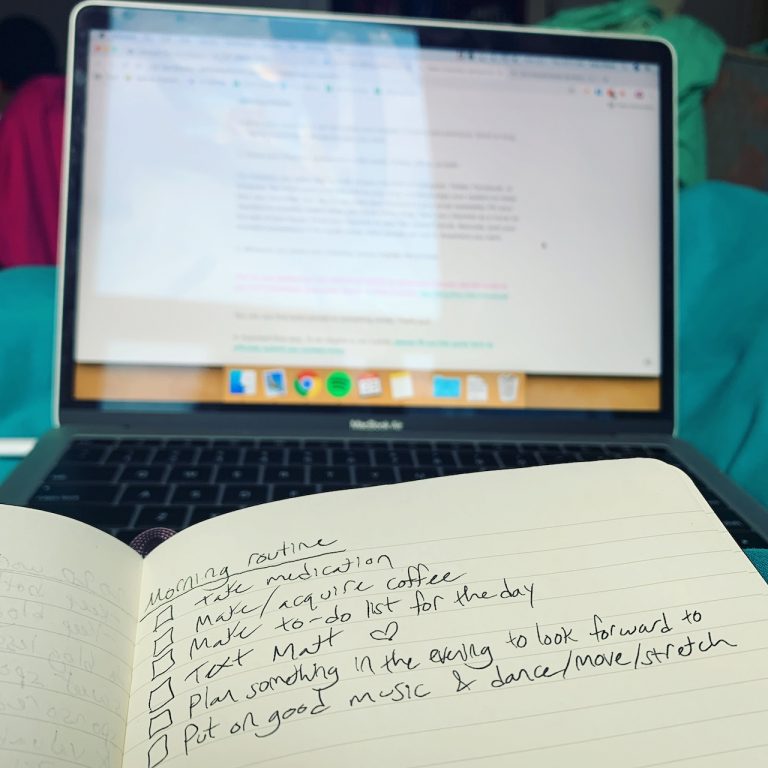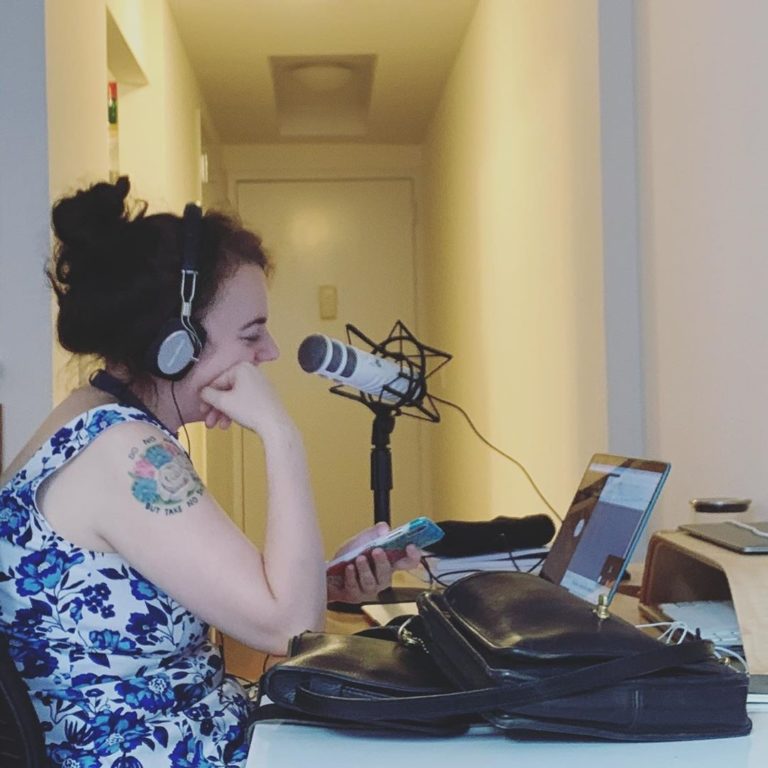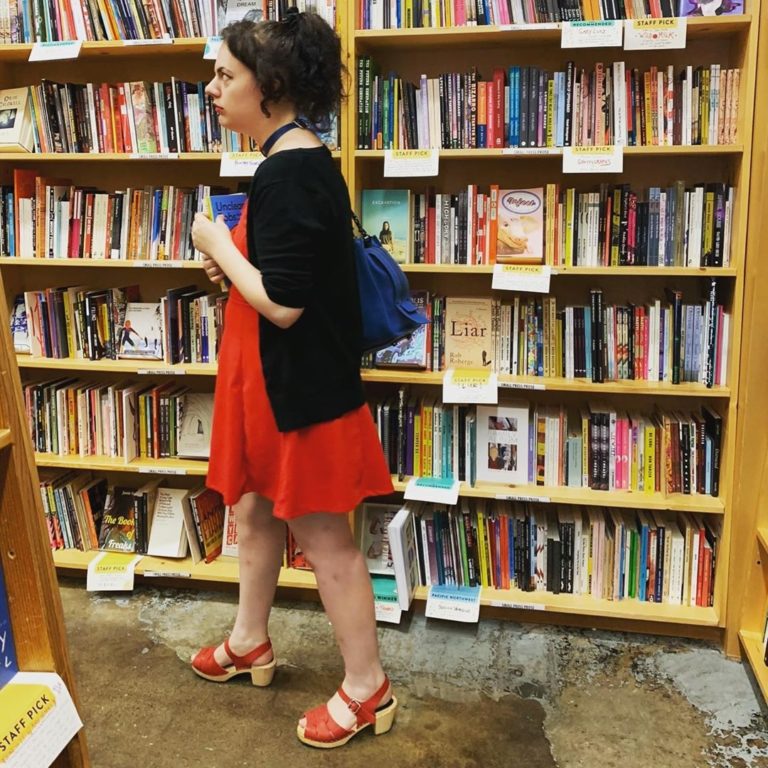
My daily routine is more affected by my chronic illness than I’d like to admit. Work can’t start until I manage to forge a path through my fatigue with the requisite amount of coffee and good music; task-switching and location-switching are informed by which positions my body can tolerate that day and which it refuses to; and when my pain decides that the work day has ended, I usually have to listen.
It’s – to say the least – a bummer, especially since I used to be renowned among my friend group and my online communities for my productivity as a writer. The same impulses still come up as before, the ones that pushed me toward creativity and stamina and long sore-eyed hours in front of the computer, but my body cannot enact my mind’s wishes on most days now and it makes me feel like a failure. Like I’m failing not only myself but also all the people who taught me how to write and all the people who believe (or believed) in me as a writer.
I seem to come back to Esmé Wang’s blog The Unexpected Shape over and over again as I wade deeper into the chronic illness life. Esmé is one of my favorite writers, and – like me – she deals with pain and fatigue (among numerous other symptoms) as part of her daily life. She’s written a lot about “creating a healthy writing practice when your health doesn’t want to cooperate,” and I’ve found her suggestions helpful, so here are some of mine, incase they can help anybody else.
I keep a to-do list almost every day, which boils down my most pressing tasks to an easily digestible form. The desire to tick those boxes and complete the list is sometimes stronger than the downward gravitational pull of my body’s limitations. When there’s only one more thing left to do on the list, usually that fact alone is enough to get me to roll up my sleeves and work on it – even if, by that point, I have to go very slowly and take many breaks.
I have a padded lap desk that I use when I’m in bed, to hold my laptop steady and keep it from overheating on the duvet, or burning my skin (temperature sensitivity is sometimes a symptom of mine). However, depending on where my pain is manifesting on any particular day, it may not always be possible to comfortably work in bed – so I move around, from the bed to the couch to the desk to the chair, looking for a few minutes of relief in which I can type a few hundred words or answer a few emails.
On days when my body is rebelling so much that even sitting at my computer feels exhausting and unfeasible, I’ll use the Notes app on my phone, which syncs to my other devices so I can easily copy and paste the text to where it needs to go later when I’m able to. I haven’t needed dictation software as of yet – the way I write and edit is exacting and particular in such a way that I get frustrated at the very thought of not being able to see what I’m writing as I write it – but am keeping it in mind for if/when my level of debilitation progresses enough to make it necessary. On especially bad days, sometimes I’ll write in longhand (I like Blackwing pencils and Moleskine notebooks; they make this process feel glamorous and easy) and then type up the words when I can.
I rely a lot on pre-scheduling. This was always true, due to the way the hypomanic episodes of my early 20s made me want to write, write, write on certain days while depression kept me uselessly crying in bed on other days. Now, I’m more aware than ever that any day – or even hour – when I feel capable of working is worth taking advantage of, if I can. Doesn’t matter if a blog post won’t be published until Thursday; one motivated and limber-fingered hour on Tuesday might be the right time to get it done. I try, as much as I can, not to leave writing tasks until the last minute before the deadline, because I can’t control what my body will be doing at that time.
I take naps as needed, which I’m fortunate to usually be able to do, due to my freelancer lifestyle. A good eye mask is a must-have for mid-day naps. My body pillow helps keep me comfortable while I’m resting. I use the Clock app on my phone to set timers/alarms so I don’t nap the whole day away.
I have a cheap microwaveable heating pad with Velcro straps that can be positioned on sore body parts as needed. I want to amass a collection of these so I don’t have to choose between treating multiple sore body parts on especially bad pain days.
Comfortable clothing is crucial, especially since my fibromyalgia-esque chronic illness sometimes causes flare-ups of hypersensitivity to scratchy or restrictive garments. I like extra-soft tri-blend T-shirts, MeUndies modal underwear and lounge pants, and (when I’m feeling a bit fancier) modal slip dresses and vintage silk robes. I particularly like loungewear that can be re-styled in an outdoors-appropriate way incase I need to dash out for a coffee or some groceries.
I’ve started using a pain tracking app to keep records of my pain’s intensity, locations, triggers, and treatments. I like this one because it’s super customizable; I can, for example, add “orgasms” as an option in the treatments category, or track my anxiety levels alongside my pain levels to see if they match up, or input impending menstruation as a potential trigger.
I’ll sometimes take a mid-day bath when my pain is especially bad, because I find the hot water gives me some relief for a while. Epsom salts are supposedly good for pain relief because of their magnesium content. Some people write in the bath; I haven’t yet figured out a way to do this that feels safe and sustainable for me, since I don’t want to get electronics close to the water and I worry about dropping my notebook into the tub. Maybe one of those wooden bathtub trays is in my future. For now, if I need to continue working while in the bath, I usually use it as reading/research time – my Kindle Oasis is waterproof and I can load it up with PDFs of my choosing, like scientific studies I intend to cite in an article or books I’m assigned to review.
Finally, one of my greatest tools in the fight against pain is cannabis – which, fortunately, is legal where I live. (By the way, why the fuck hasn’t Canada pardoned and freed everyone who is incarcerated on cannabis-related grounds? It’s bullshit with hugely racist motivations and manifestations. Anyway…) Usually weed makes me too spacey/giggly to work properly, so I mostly leave it until the end of the day when all my work is done, but sometimes my pain is bad enough that I need to treat it in order to focus on any task. In that case I’ll try to pick a strain high in CBD and low in THC, use it sparingly, and schedule my day so that I’m doing highly methodical or highly creative tasks while high – never anything requiring a lot of logical analysis or careful phrasing.
That’s what’s working for me right now. I’d love to hear from other chronically ill writers in the comments (or in your own blog posts, if you prefer – send me a link please!) about how they manage their symptoms and get their work done.
Additional resources I’ve found helpful on this topic:
- 5 Tips for Writers Limited by a Chronic Illness by Dr. Sarah Boon
- Writing Your Disability or Chronic Illness by Kate Horowitz
- Writing with Chronic Illness by Maya Strong
- So You Want to Write a Book While Chronically Ill? Here’s What You Need to Know.



